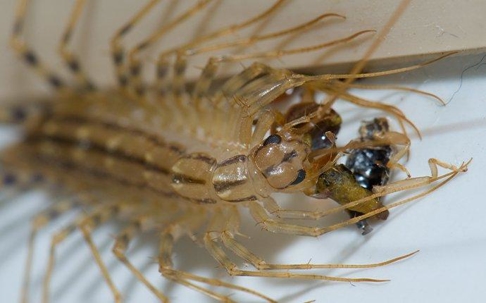Do you know that centipede means 100 feet, even though no centipede in the world has a hundred feet? It's true. Some centipedes can have as many as 350 feet (if you can call them feet), but they never hit the magic number of 100. Why? There are two reasons. First, they have two legs per body segment. Second, they always have an odd number of body segments. That means they'll never have fifty segments and one hundred legs. So they are never 100-footed. But that little fun fact, and about $6, will get you a cup of coffee at some coffee houses. There are lots of resources on the internet to find fun facts like this one but, at the end of the day, fun facts won't help you keep these multi-footed pests out of your home. So let's dig in and talk about why these bugs become pests in Aiken, and what you can do to keep them from entering your home.
What Centipedes Want
The first step in centipede control is understanding what these creepy bugs with all those legs are looking for in your home. There are two top priorities for centipedes: food and moisture:
- Food — Centipedes eat bugs. If you have lots of centipedes showing up inside your home, you can conclude that you have lots of other bugs inside your home. Addressing those other bugs will help you to get control of centipedes.
- Moisture — Centipedes get dehydrated easily because they can't retain moisture well. This is why you find them in damp locations in your yard, such as underneath woodpiles, boards, stones, mulch, and more. When they get into your home, they'll hide in locations of high humidity. If you work to control the humidity in your home, you can have an impact on how many centipedes you see.
Why Centipedes Get In
When a centipede is on the outside of your home, it doesn't think to itself, "I bet that is a nice place to live." It gets into your home by accident as it crawls around on your foundation walls and exterior walls. You can reduce the number of centipedes that get in by addressing potential entry points:
- Wood rot that is caused by water damage is the most likely way a centipede will get into your home. This is because they crawl around in moist locations. When they find a hole created by a pest that chews (or eats) decaying wood, they crawl inside.
- Exterior doors can give centipedes a few options for entering your home. They can slip under a door that has no door sweep or a damaged door sweep. They can slip through gaps in the rubber seal around the door, particularly at the bottom. They can squeeze through gaps around the door frame, or holes that have been created by wood-destroying pests.
- Exterior windows have a few vulnerabilities. If you have a window with a damaged screen and a damaged frame, centipedes could find a pathway inside. They'll also exploit openings in the seal around the frame.
- Cracks in foundation walls may be deep enough to give centipedes entry. It is a good idea to seal any cracks you can find.
- Gaps around pipes that pass through your foundation walls or broken seals around pipes can provide quick access.
How A Professional Can Help
Once you've done what you can do to control bugs, reduce moisture, and seal entry points, you might not see any centipedes getting into your home. If so, you're all set. But every home has its challenges when it comes to pest control. You may have entry points you can't get to or conditions around your home that promote bug activity. In these cases, a professional pest control plan can give your exterior the added protection it needs to keep bugs (and the centipedes that eat them) out of your home. If you need assistance with pest control in Aiken, reach out to us. The licensed pest professionals at Aiken Pest Control are standing by to help.

